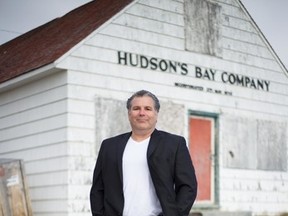ON CAMPUS: Making a difference in the tundra

Article content
It’s difficult to imagine what a traffic jam might look like on Baffin Island, but every day, in the heart of Iqaluit, cars are lined bumper-to-bumper at the city’s busiest intersection.
“The entire city shuts down at 12 o’clock, almost en masse, so everyone can leave work to spend lunch with their families,” said David McAdams, a graduate of Loyalist College’s post-graduate human resources management program. “There’s a solid streak of cars for almost two kilometres, in all directions. It says a lot about the culture here.”
McAdams, who moved to Nunavut in 2016, is the Manager of Human Resources at the Qikiqtani Inuit Association in Iqaluit. The Association is one of three regional Inuit organizations for the territory and consists of 13 communities on Baffin Island, stretching from Grise Fiord on Ellesmere Island (one of the coldest human-inhabited places in the world) to Sanikiluaq, Nunavut’s southernmost community located on Flaherty Island in Hudson Bay.
The objective of the association is to advance the rights and the benefits of Inuit peoples in the Baffin region; to protect the values of the environment, resources, traditions, languages and economic opportunities; and to provide a global representation for Inuit.
One of the reasons McAdams moved to Iqaluit was to work with Indigenous peoples and to experience life in the north. Nunavut is an emerging territory. It was established in 1999 when it officially separated from the Northwest Territories, making it Canada’s newest, largest and most northern territory. Its youth gives it the opportunity to write new rules and create unique work environments reflective of its culture. It’s a place where everything and anything is possible.
Being a part of the association has exposed McAdams to ‘country food.’ It’s not uncommon for him to find local foods such as caribou, walrus, seal, muktuk or arctic char in the staff kitchen. Sharing is ingrained in the culture.
McAdams came to Loyalist when he was 50 years old. Prior to his studies, he had spent many years working with labour agencies and recruitment centres. Occupational safety and employee relations became part of his day-to-day responsibilities. That’s when he realized he had transitioned from operations to human resources (HR) and career development.
“I pursued post-secondary training in HR so I could validate all of the work that I’ve done,” he said. “The one-year program gave me the ability to go into the classroom and prove that I really understand my field. It also reaffirmed that I didn’t know everything that I needed to know. There’s always more to learn.”
Moving north was a learning curve in itself. It was the first time McAdams was exposed to Inuit culture and he found himself having conversations with his colleagues about how to measure skills.
“Other provinces measure skills very differently than we do here,” he said. “Imagine the skills it takes for a hunter to hunt seals. You need to know the land, seal habits, wind direction – there’s a lot of historical knowledge. It’s the same for understanding sled dogs. The people who work with the dogs know their story, where they came from and the role each plays in the pack. Those relationships are complex and there’s a deep comprehension of group dynamics.”
One of the greatest joys of the job is being able to present someone with an opportunity which leads to success.
“As a lifelong believer in empowering people, my greatest career achievement is advancing the careers of others,” he said. “It’s exhilarating to share a person’s success, even as a bystander.”